Yesterday I presented Part One of my tour of the United Kingdom Pavilion. Today I’ll finish the journey.
At the back of the United Kingdom Pavilion you’ll find 1800’s England and the residential section of town. On Tudor Lane we discover a stately home. Within this structure is the Lords and Ladies shop. This boutique sells fine apparel and fragrances for men and women. Be sure to take a look at the ceiling in this shop. It’s exquisite.
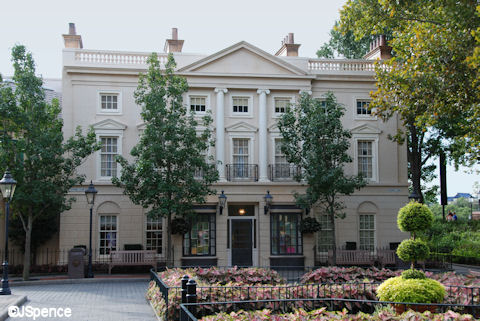
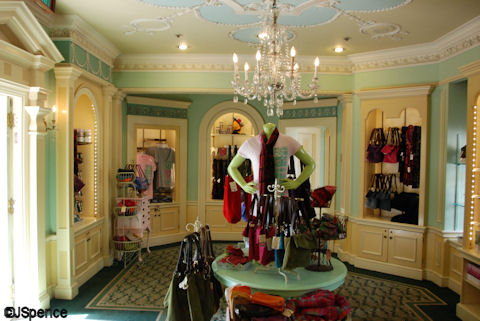
On Upper Regency Street we find Late Georgian row houses. These were inspired by the homes of Belgrave and Bedford Squares in London. Row houses originated in Great Britain in the late 17th century. This medium-density housing concept placed identical or mirror-image houses side-by-side with a shared wall between them. The first and last of these units were called an “end terrace” and were often larger than their interior counterparts.
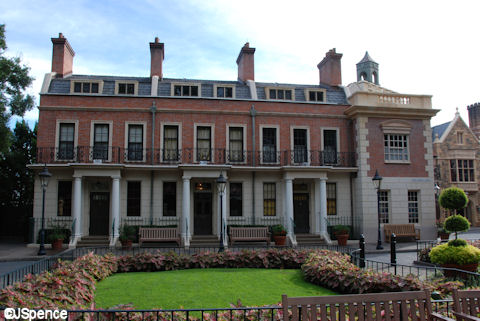
Inside this building is a Kidcot Fun Spot. This is the place for little ones to engage in some age appropriate activities while their parents enjoy the more adult offerings of this pavilion. This is also the place to get your Epcot Passport signed and stamped. Winnie the Pooh can often be found in a back corner of this room.
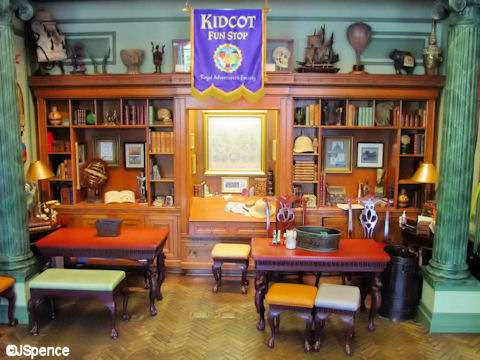
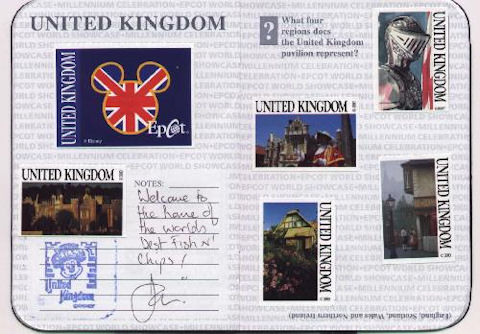
Details are everywhere if you take the time to look. Above the Kidcot station is a tribute to Charles Darwin and his “On the Origin of Species.”
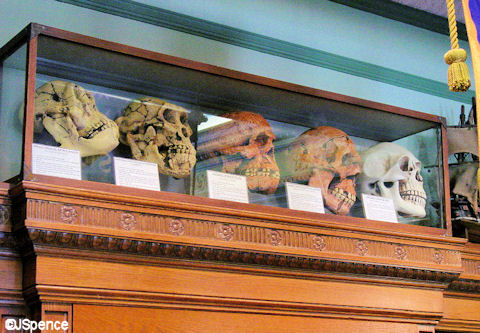
The row houses face out onto Disney’s version of Hyde Park. Anyone familiar with the real Hyde Park knows that this replica has been scaled down considerably. This area is one of the most peaceful in World Showcase. There are a number of park benches throughout the square and this is a wonderful spot to just sit, relax, and soak in the ambiance.
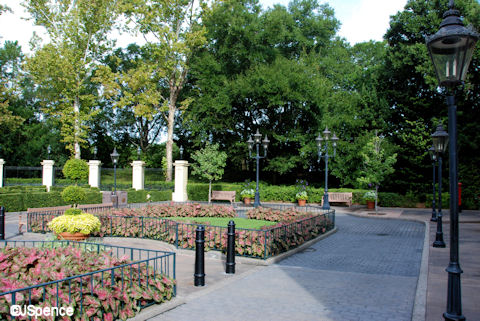
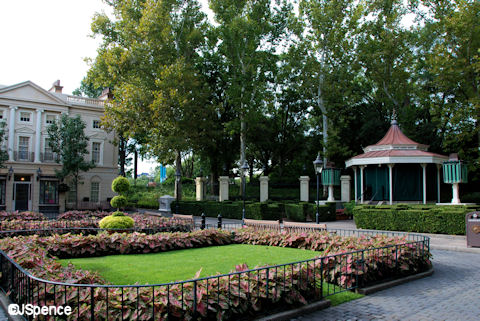
The park also includes a gazebo perfect for afternoon performances. Currently, a group called British Revolution performs mini-rock concerts several times each afternoon/evening. Numbers include hits from British groups Led Zeppelin, The Rolling Stones, Sting, The Who, and the Beatles. Check your Times Guide for days and times.
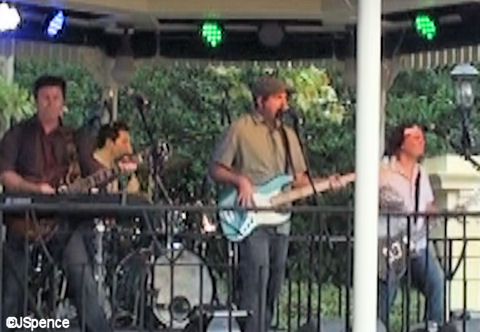
Surrounding the gazebo is a hedge-maze fashioned after the Somerleyton Hall Maze created in 1846. Note, the bushes are about 2½ feet tall so only the youngest of children would find this puzzle challenging. However, it’s very common to see adults maneuvering through this classic English maze.
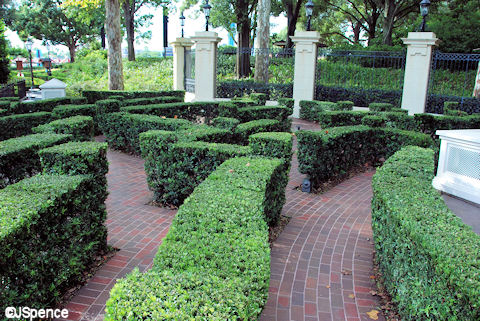
The first British pillar post boxes were erected on the island of Jersey, a British Crown Dependency off the coast of France in 1852. This was necessitated due to the irregular sailing times of the Royal Mail packet boats serving the island. Someplace was needed where the inhabitants of Jersey could safely leave their letters for later pickup. The first pillar boxes were made of cast iron, octagonal in shape, and about 1½ meters high. These boxes were an instant success and quickly spread across Great Britain. A typical pillar post box of today is on hand for the residence of Upper Regency Street and Tudor Lane.
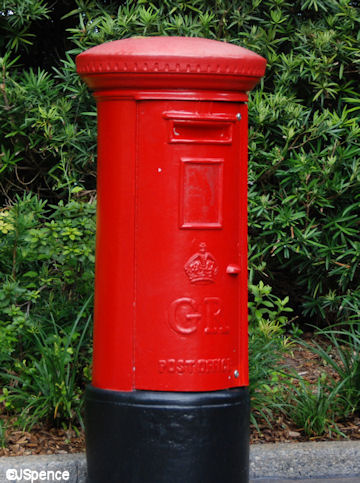
During the Middle Ages, many cities were surrounded by a protective wall to keep invaders out and its inhabitants safe. City gates were built into these walls to provide a controlled access to those wishing to enter or leave the city. In addition, the city gate became a hub of public information such as announcements, tax and toll schedules, and standards of local measures. One of the best preserved walls in England can be found in York. The United Kingdom Pavilion’s city gate is inspired by this example.
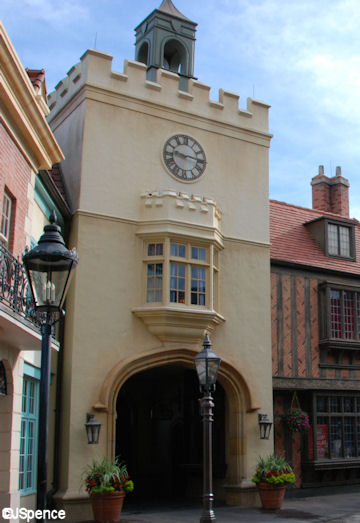
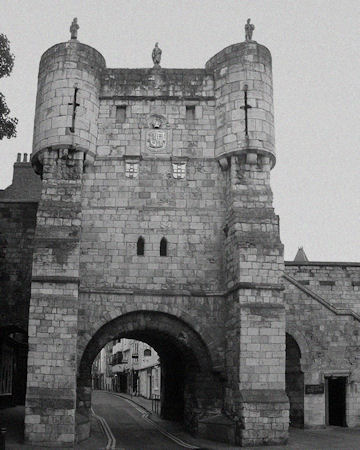
Within the city gate guests can gain access to The Toy Soldier shop. Besides an array of English toys, a large collection of Beatles merchandise is on hand. In addition, Paddington Bears can be found here.
Paddington Bear is a classic character from English children’s literature written by Michael Bond and first illustrated by Peggy Fortnum. Paddington is an immigrant from Deepest, Darkest Peru and is perpetually polite to everyone. He always addresses people by “Mr.”, “Mrs.” and “Miss” and very rarely uses their first names. But despite his respectful demeanor, Paddington always finds his way into predicaments. Paddington books have been translated into thirty languages and the more than seventy titles have sold 30 million copies worldwide.
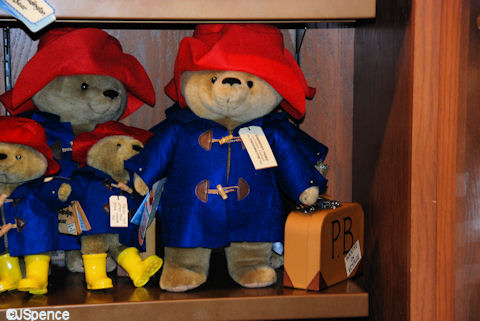
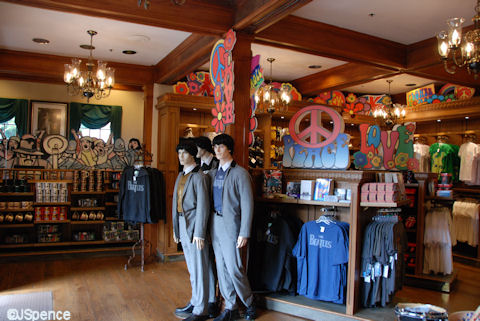
Next to the City Gate we find the Crown and Crest shop. Notice how the second story overhangs the first floor. In the 1600’s, taxes were based on ground-floor square footage. So the resourceful folk of the time built larger upper floors to increase living space without increasing taxes. In addition, this overhang allowed residents to throw wastewater from the upper floors onto the street without soiling their own windows and doors. This cantilever architecture can also be seen in The Queen’s Table building across the street. This section of the Crown and Crest sells “pop” British items like mugs, t-shirts, and handbags.
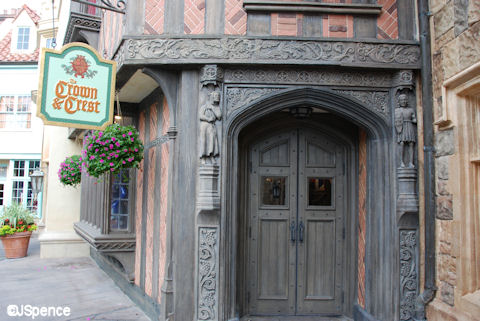
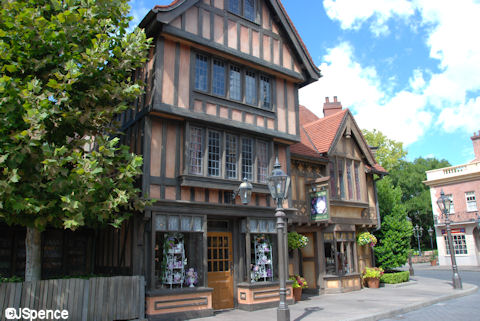
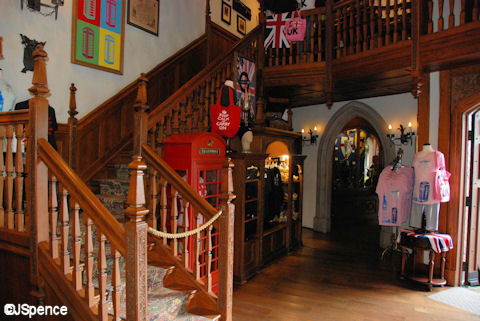
The Crown and Crest shop spills over into the large stone structure next door. This building was modeled after Sir Walter Scott’s Abbotsford Manor. The name Abbotsford came from a spot on the River Tweed where Melrose Abbey abbots forded the stream each day. The castle design is Scots Baronial which is part of the Gothic Revival style of architecture. Be sure to notice the decorative drainage spouts just below the roof.
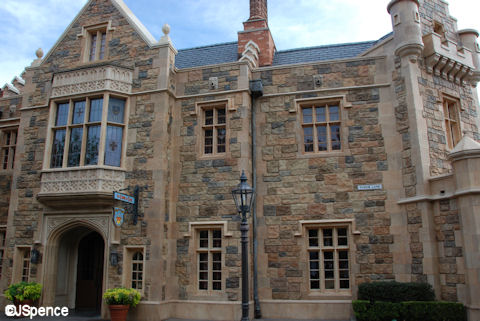
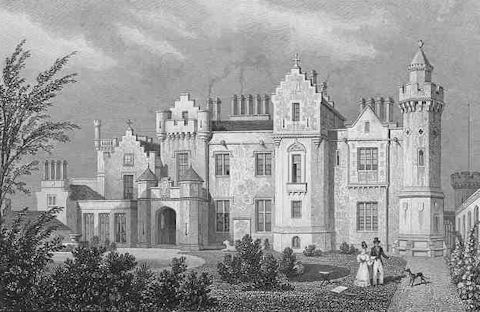
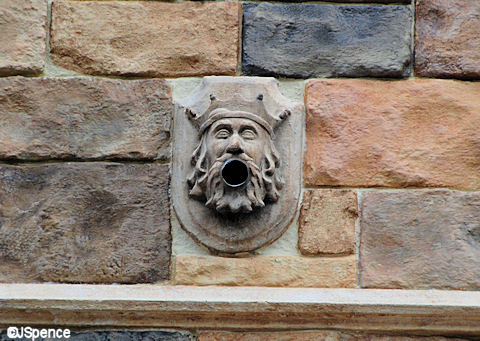
The interior of this castle is equally impressive. A massive fireplace, heavy wood furnishings, a vaulted ceiling, and medieval weaponry combine to create an imposing statement.
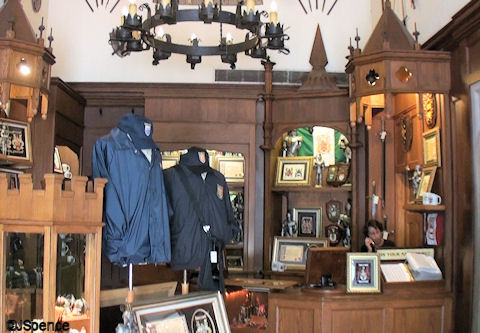
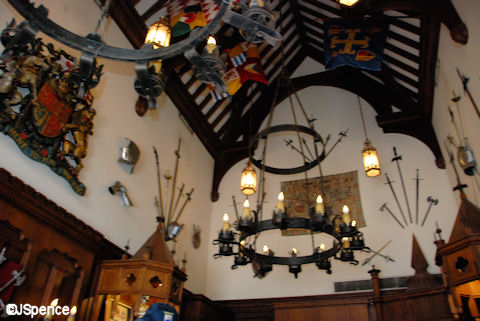
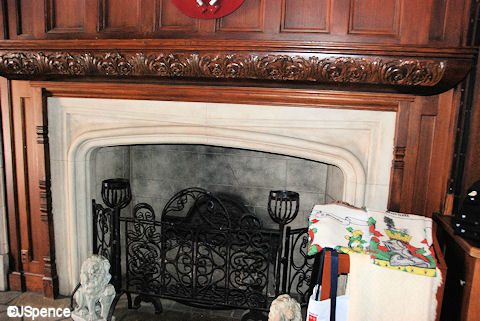
The Crown and Crest shop sells one of the most unique items to be found anywhere around World Showcase. Here you can look up your last name via a large book or computer and view your coat of arms.
Historically, coats of arms were first used by knights and feudal lords in the mid-12th century during battle as a way to identify friend from foe. As time progressed, non-military persons began to adopt their own coat of arms. Quite often, those closely associated with knights and lords “borrowed” their design and made it their own. Eventually the clergy, common folk, towns, and cities were sporting their own heraldic insignia. In some areas, the acquisition of a coat of arms was regulated, but most of Europe let their citizens freely choose their armorial bearings.
In addition to finding your coat of arms, a history of your last name is also available at the Crown and Crest. If you like what you see, there are several ways to take your birthright home with you. One of the most popular is to have your coat of arms and name history beautifully framed.
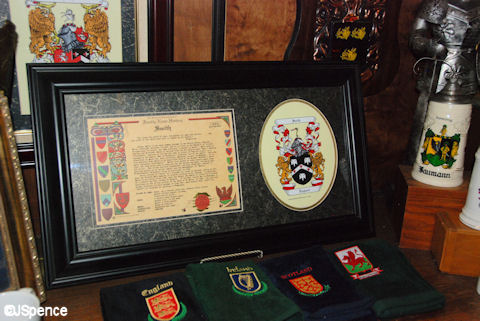
The last building I’m going to discuss was modeled after Hampton Court Palace located at Richmond upon Thames, Greater London. This imposing brick structure features Tudor architecture which was the final phase of medieval architecture.
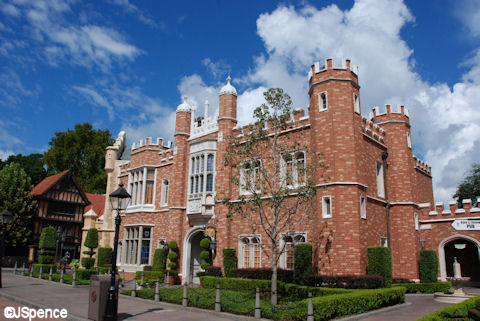
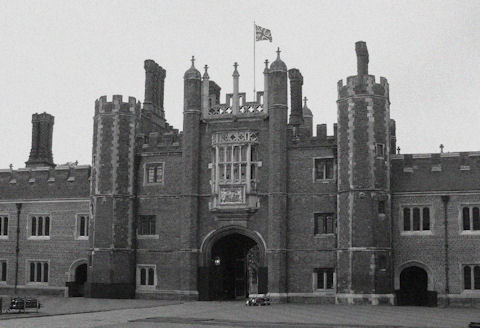
When visiting here, be sure to check out some of the windows. In the upper left-hand window are the crosses of St. Andrew (the patron saint of Scotland), St. George (the patron saint of England), and St. Patrick (the patron saint of Northern Ireland). If you overlay these three crosses, they create the Union Jack.
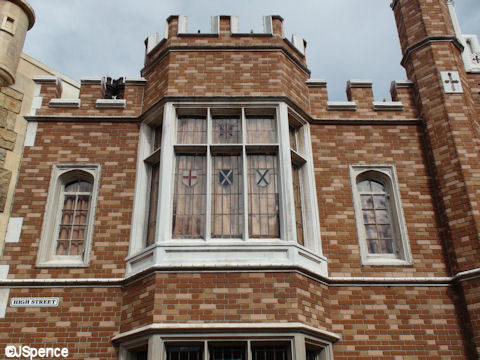
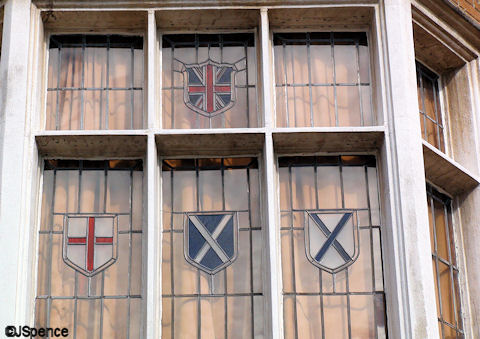
The coat of arms above the door was inspired by the one representing Hampton Court Palace.
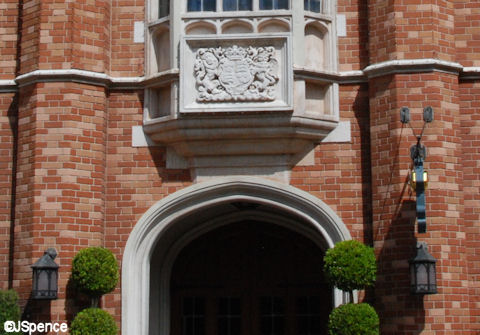
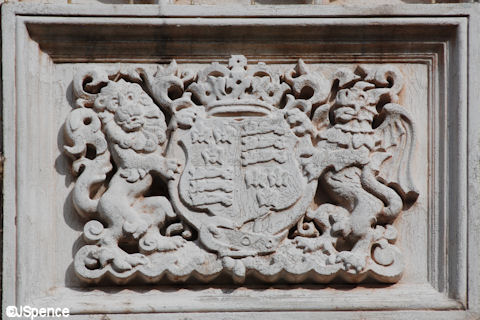
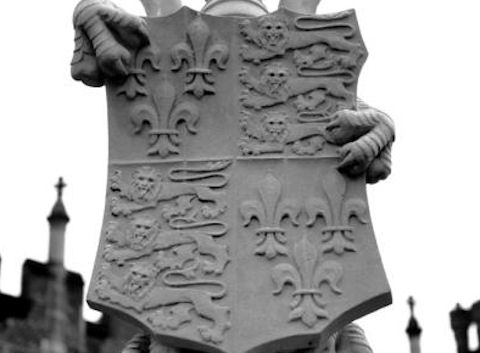
While you’re still outside, be sure to check out the chimneys. It would be difficult to find any more ornate. Also notice that the Imagineers tinted the tops with soot-coloring to make it appear as if they are actually in use.

As you enter the building, take a moment to admire the model of a medieval banquet hall. This delightful vignette features royalty, nobles, musicians, jesters, and a host of service people enjoying a sumptuous feast.


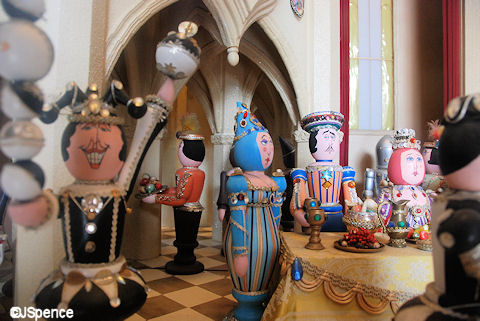
The Sportsman’s Shoppe is housed within this Hampton Court inspired building. Inside you’ll find British sports related t-shirts, logo-emblazoned equipment, and some drinking paraphernalia. Be sure to take a look at the woodworking and ceiling in this store. It’s remarkable.
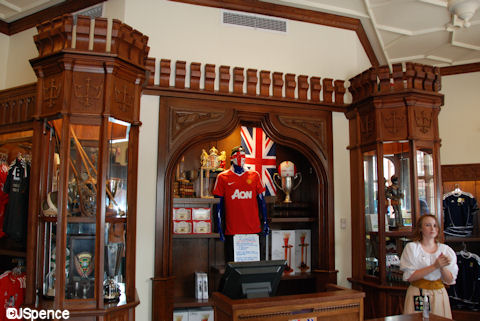
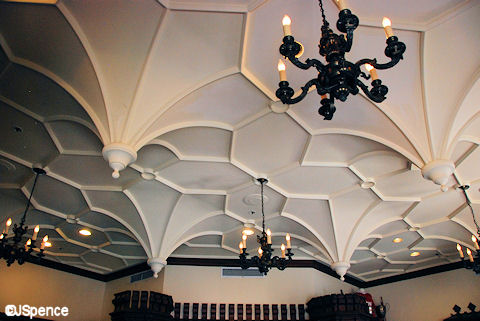
The United Kingdom Pavilion also offers convenient restrooms. It’s probably no accident that they’re located directly across the street from the pub. Also in this area are a typical English Renaissance garden and a fountain. I was caught in a summer downpour once while using these restrooms. Even though I had a poncho, it was raining hard enough to keep me in place for about 15 minutes. I only ventured out long enough for this picture.
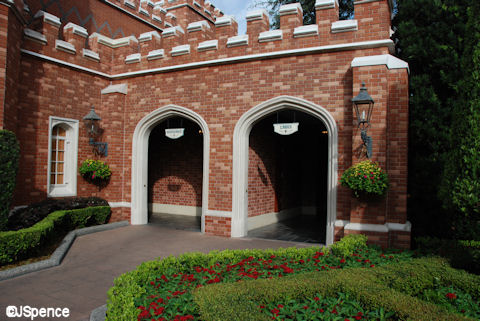
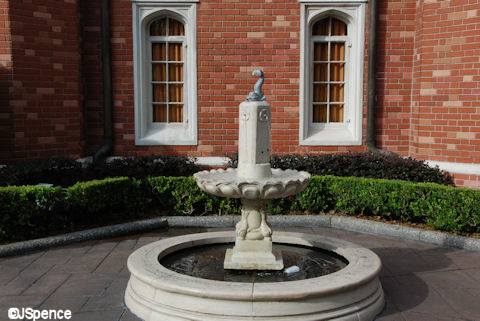
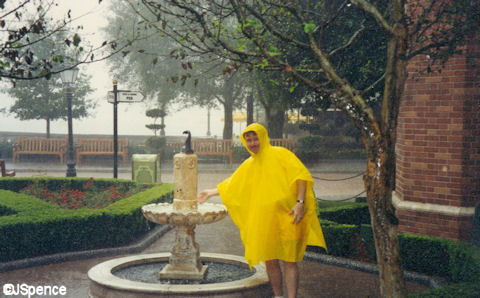
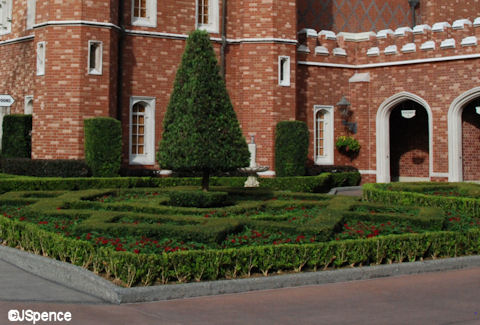
The first standard telephone booth in the UK was introduced in 1920 and did not look like the classic red kiosk we know today. In 1923, a competition was held for a new design, but the results were disappointing. So the contest organizers invited three respected architects along with designers from the Post Office and The Birmingham Civic Society to submit entries. When the judging was complete in 1924, a design submitted by Giles Gilbert Scott was selected. Although minor changes have occurred over the years, this basic look remains the same today. However, just like in the States, cell phones have greatly decreased their numbers.
The United Kingdom Pavilion boasts three of these classic red phone kiosks. Two near the restrooms and one outside the pub. It’s a common sight to see guests cramming as many people as possible into one of these booths. These phone booths also make fantastic photo opportunities.
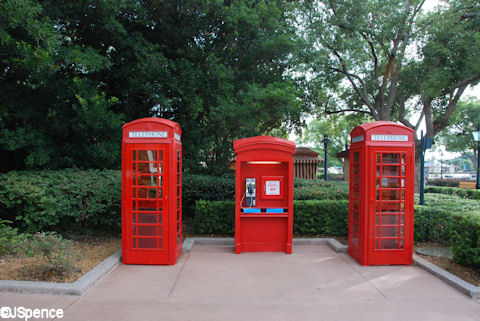
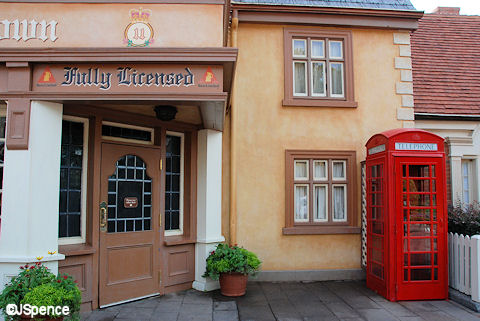
To help set a mood, each World Showcase pavilion plays music appropriate to that nation. When walking through the United Kingdom Pavilion, you’ll hear selections from Gilbert and Sullivan, Greensleeves, and other familiar British tunes. You’ll also hear the haunting “Stranger on the Shore.” Believing this was an American song, I’ve always wondered what this melody has to do with Great Britain. So I did a little research.
I discovered that “Stranger on the Shore” was written by Acker Bilk, an English clarinetist known for his trademark goatee, bowler hat, striped waistcoat and his distinctive clarinet style. Acker wrote the song for his daughter Jenny and it was later used as the theme song for a BBC TV drama series that was also called “Stranger on the Shore.”
The song was released in England as a single in 1961and was an instant success. The song spent a year on the Record Retailer Top 50. It was the United Kingdom’s bestselling single of 1962 and the UK’s bestselling instrumental single of all time. On May 26, 1962, “Stranger on the Shore” became the first British recording to reach number one in the U.S. Billboard Hot 100.
No wonder I thought it was an American song. I was only ten when I first heard it and no one told me otherwise. Silly me.
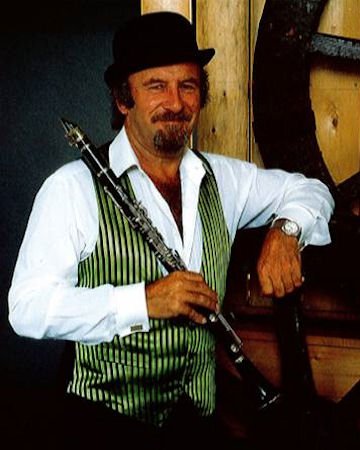
That’s it for the United Kingdom Pavilion. As always, I have a video that captures what still pictures cannot. Enjoy.

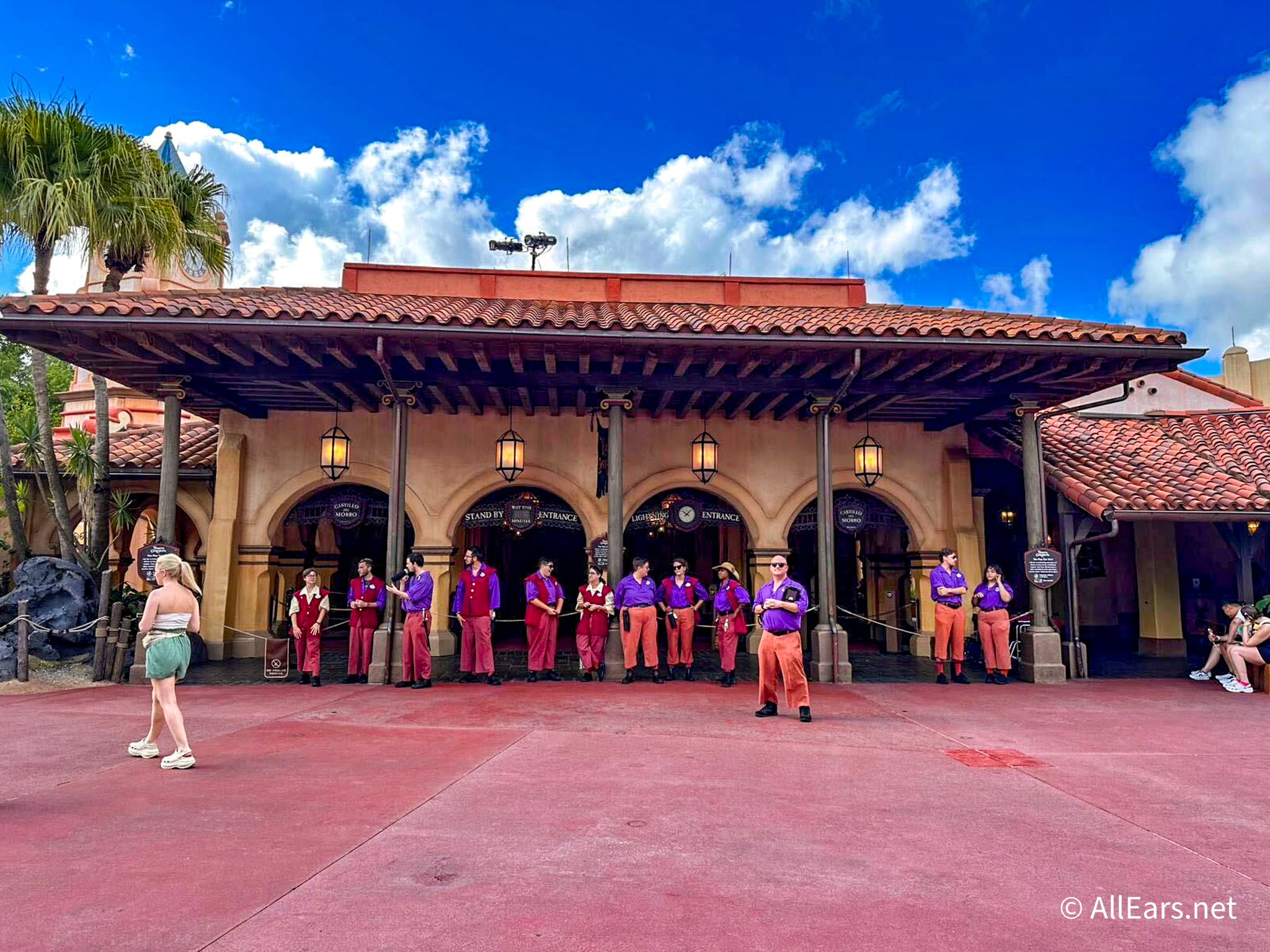


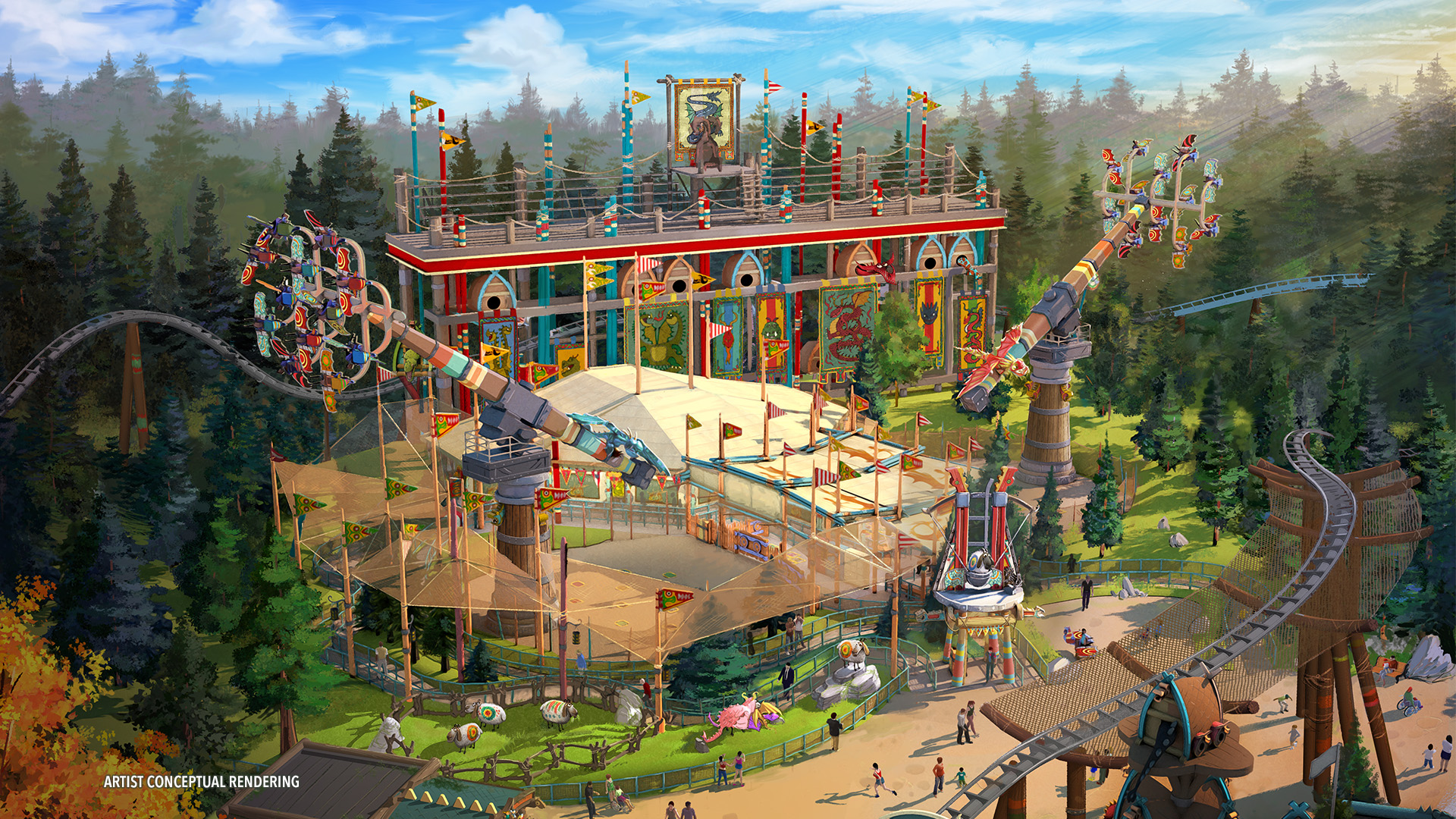
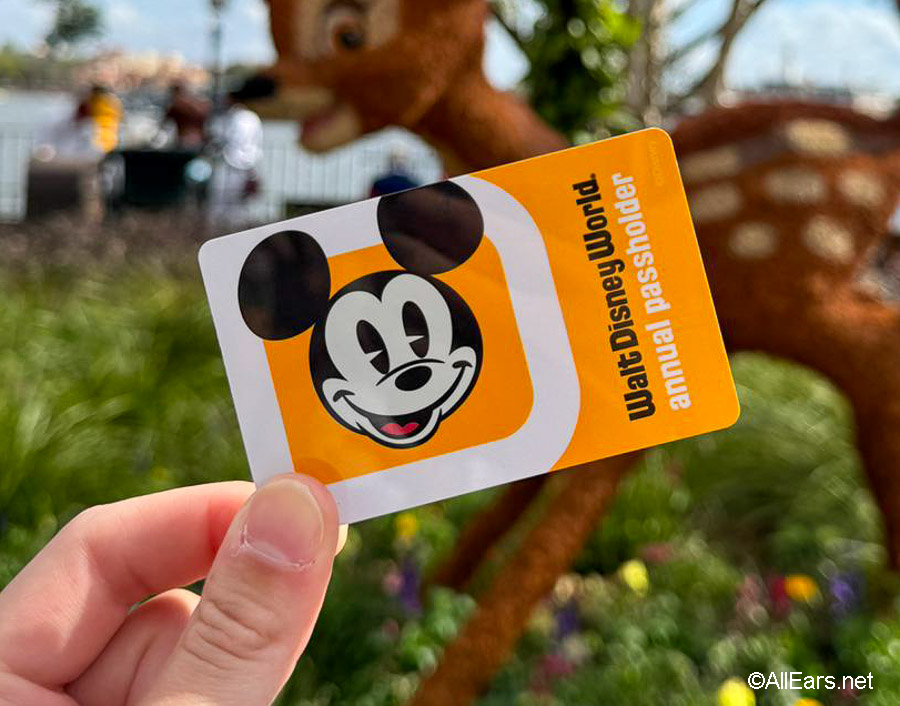
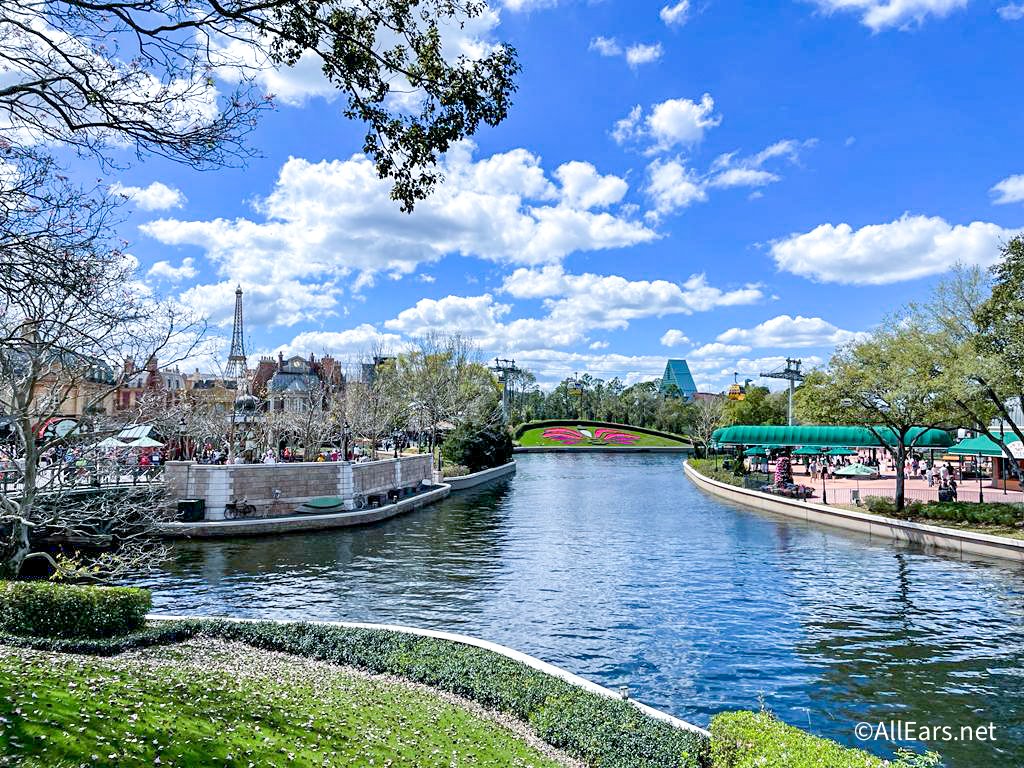
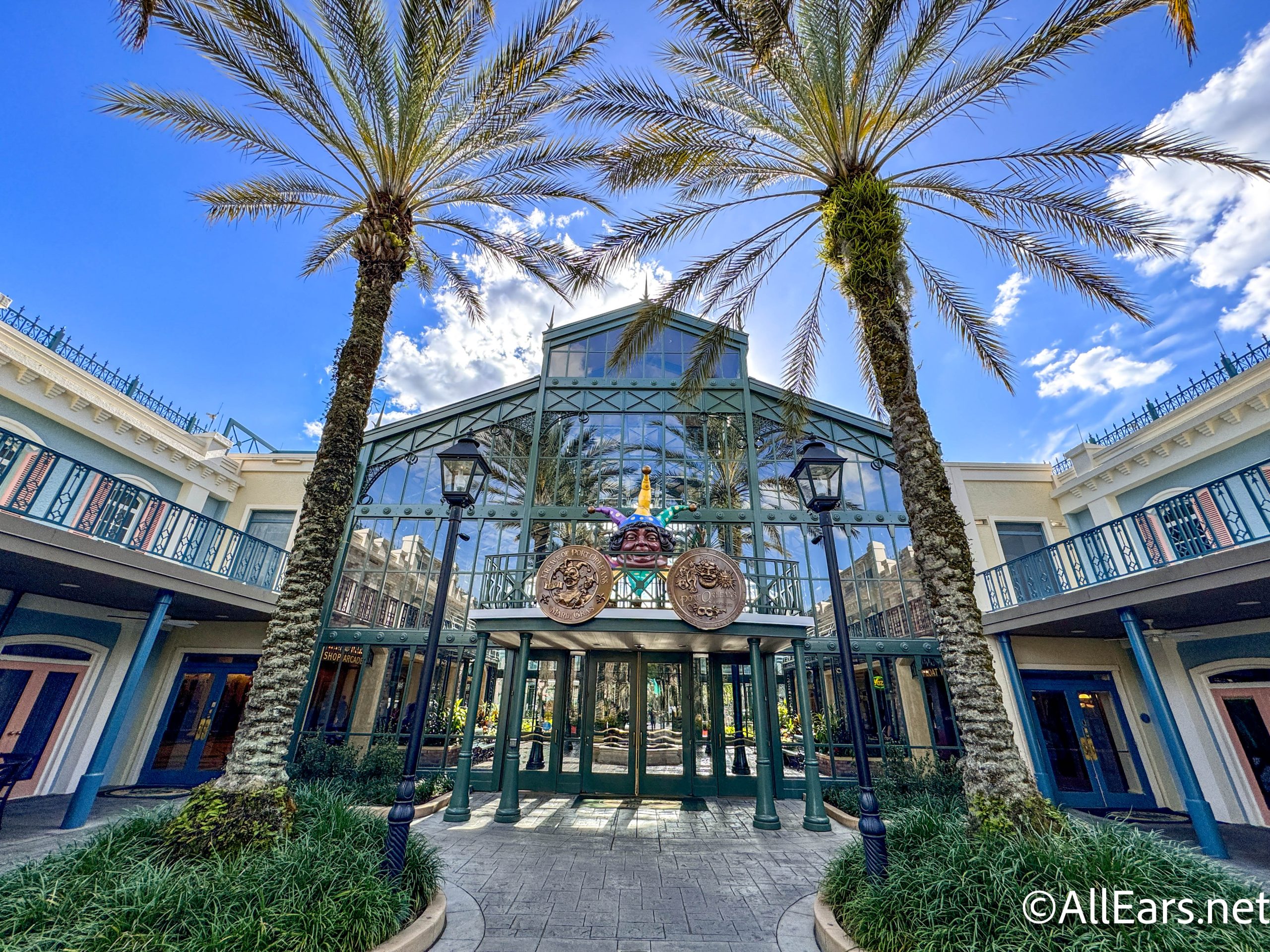


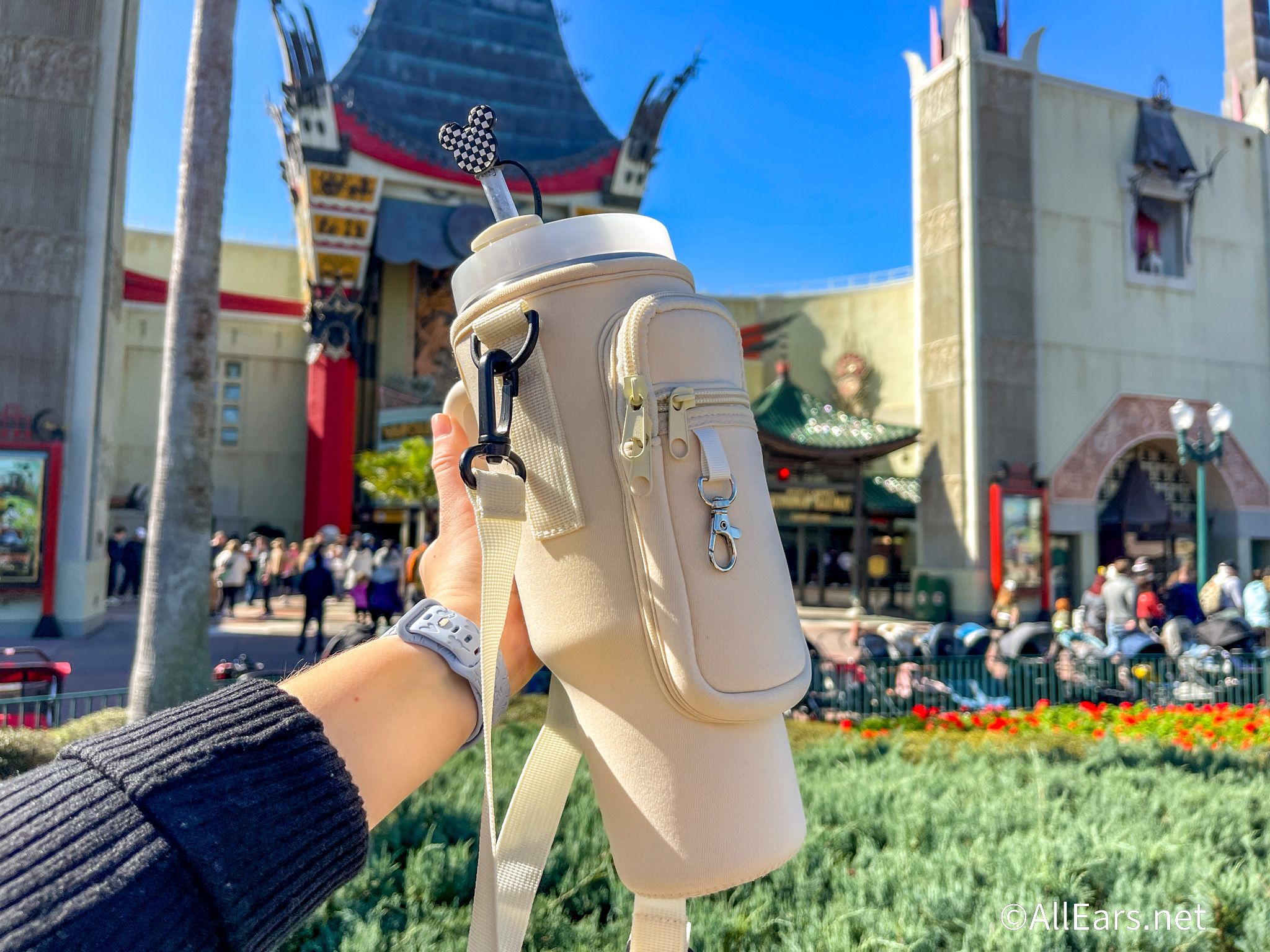
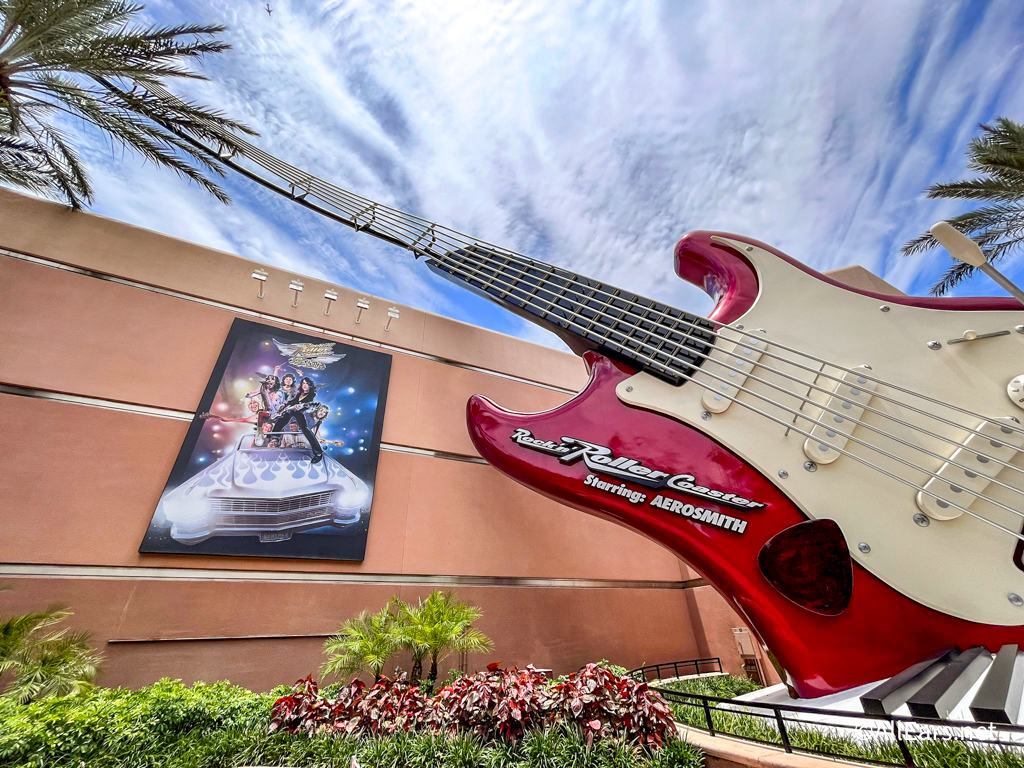

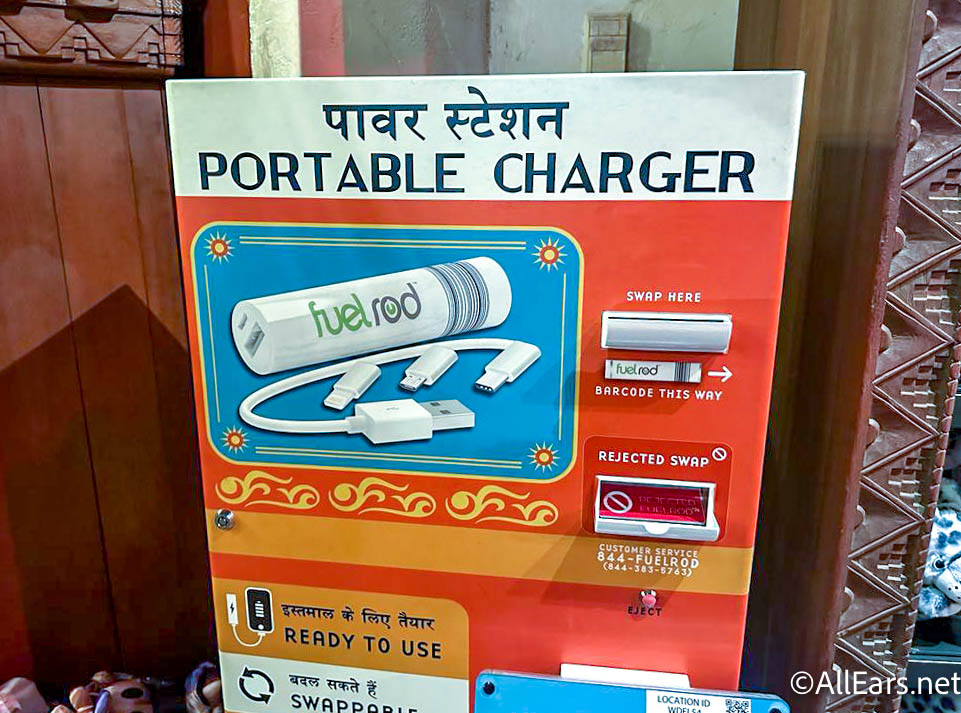

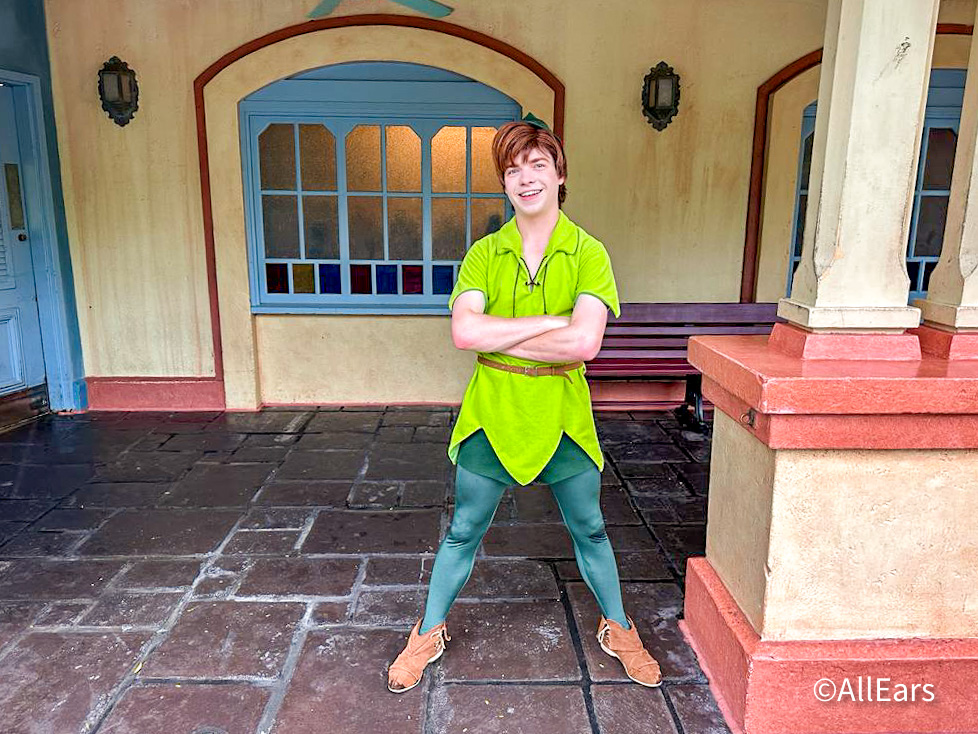
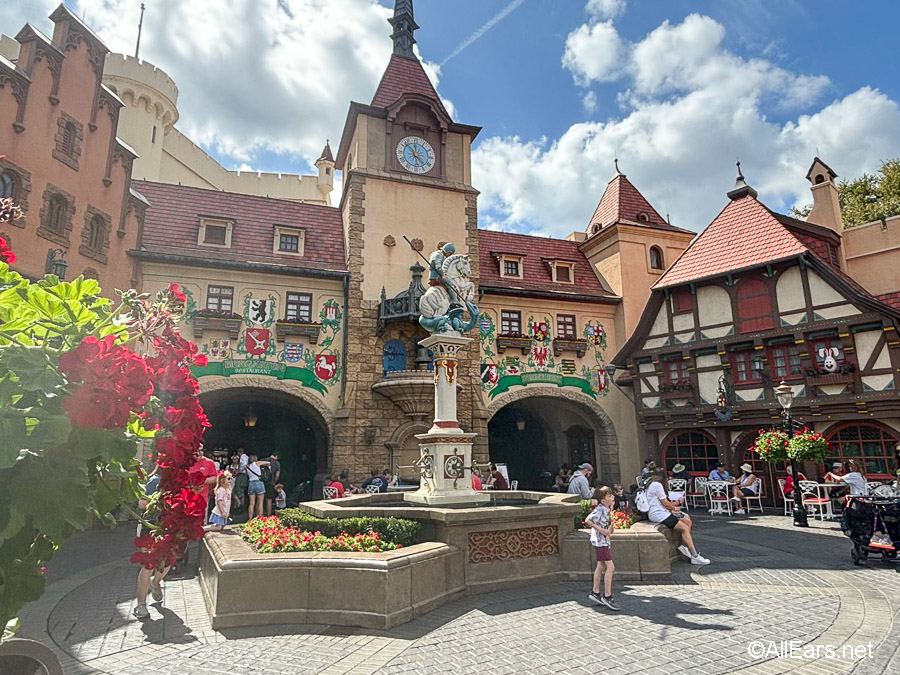


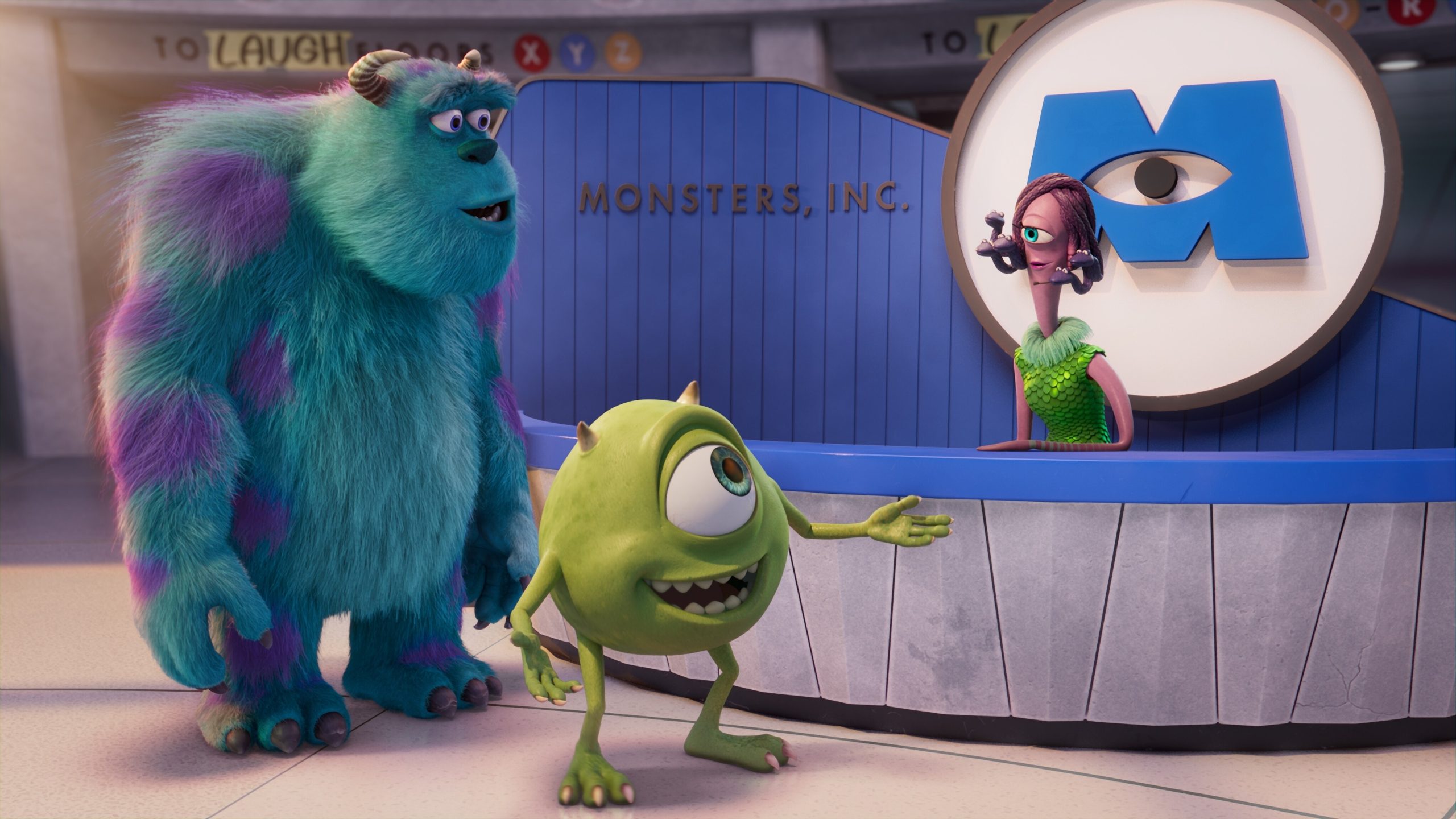


Absolutely superb! Watching this was a great way to spend a rainy Sunday. However, I do not think that I could pass a quiz right now on all the information given. The thought that Disney puts into each attraction is extraordinary.
Hi Jack,
Great attention to detail as always. I would like to add my recent Disney memory to the commentary. We were in Epcot two weeks ago first thing in the morning and everything was nice and quiet. We had alot of time to meander around the countries before the crowds set in. As soon as we got to UK my kids ( 9 and 6 ) started screaming and running and just soaking up the UK phonebooths. It took me a couple minutes to realize, (thanks to modern technology) that they have never seen a phone, outside of a building, in a booth! I couldn’t help but laugh and at the end of the day, one of the cooler things they have seen was a real phone in its own little “house”! 🙂
OK, I saw your response to Wendy that you are currently working on Morrocco. Were you there on Friday Sept 23 with a camera on a monopod?
I thought it might have been you, but was too star-struck to say “Hi!”.
Jack’s Answer:
Yup, that was me. You should have stopped me and said “hello.” I love to chat about Disney.
What a fantastic post. I love the UK and France pavilions and never realized just how much detail went into creating every World Showcase pavilion. Excellent excellent work and I can’t wait to see the other pavilions!
The crest on the Sportman’s Shoppe is one of the English Royal coat of Arms. According to wikipedia (ok, not the greatest source for info, I know, I know) – the Fleur De Lis were first added to the coat of arms by King Edward III. This was because Edward III made a claim to the French throne as well as the English throne. I suppose this was kind of an opening salvo in the Hundred Years war.
The English Royal coat of arms kept changing over the years but they kept reverting back to this one. It was used for about 146 years if I calculated it properly. The only royal coat of arms that had a greater lifespan was the 3 gold lions on a red background that Richard I used as his second Great Seal of England. The current Royal Coat of arms for the UK (not just England) has been in use since 1837 and represents the kingdoms of England, Scotland and Ireland.
King Henry VIII was the first sovereign to use Hampton Court Palace and it bears his Royal coat of arms. The structure was initially built by Cardinal Wolsey, who fell out of favor with the King and turned the palace over in 1528. Henry VIII then expanded it significantly.
Hope I got that all right!
Thanks for the great blogs about the UK pavilion, it’s one of my favorites, although I think that 90% of the pavilions are “one of my favorites.” I love the special attention to detail and I’ve never taken as much time as I should to look at the buildings in the area. I knew the history behind the different eras represented by the Pub building, but not the rest. I especially liked the bit about the Hampton Court building and was surprised to see that the actual Hampton Court crest is 1/2 French in nature. Any idea why the battle symbol of the King of France is on their crest? I guess I might have to do some research.
Jack’s Answer:
I tried to do more research on some of the other crests, but ran out of resourses and time. Maybe someone else can answer this question.
Jack, I really cannot tell you how disappointed I was to see your goodbye post a few months ago. Your expertise as well as genuine love for Disney World have drawn me to your blogs and the thought of losing you made me feel like I had lost a friend. To see your continued blogs is such a blessing. Thank you for taking your time to stay connected – even if you can only write once a quarter, just knowing we will eventually see your blog again is enough for me. My sons (12 and 7) love reading your column too- my youngest thinks “you know EVERYTHING!” Thanks again for being here!
Jack,
I’m catching up after being out on vacation – I have to say that your informational pieces on the resorts and showcases are exceptional. Your selection of pictures and videos really illustrate the written descriptions, which isn’t that easy to do. They are obviously well thought out in advance and the attention to detail is great.
Someone may have already asked, but how long does it take you to compile everything you need for each one? Do you scout each showcase before heading in with the cameras (I’m guessing yes)? Do you have to cut certain details in the interest of flow and/or space limitations? Also, when writing up the descriptions for the showcases are you doing it from front to back to front? I’m afraid it’s been quite a while since I’ve been in the parks and still working out the orientation of the buildings for each showcase.
Jack’s Answer:
The length of time it takes to create a blog varies, depending on the subject, but I’m finding the World Showcase Pavilions are taking me about 40 hours each. I start by videotaping the pavilon. This requires being at World Showcase at opening (11am). I have about 20-30 minutes of “people-free” filming time available. Sometimes I have to come back for “make-up” shots. However, that doesn’t mean I can leave Epcot at noon. Most of the entertainment doesn’t begin until after 1pm or later and I must stick around to capture a segment of each show.
I must return on another day to take the “still” pictures. Once again, I must arrive at 11am to get people-free picture. Unfortunately, I really can’t take stills and videos on the same day. It just doesn’t work.
It take me between 6-8 hours to edit the video and add music. It take another hour to upload the video to YouTube.
Then it quite a while to research and write the article. Every picture I use must be shrunk and my name printed on it. Once I’ve completed the article and pictures, It can take me about 45-60 minutes to upload it to AllEars. Each picture must be uploaded one at a time and labled.
So I easily spent 40 hours creating France, the UK, and upcoming Germany Pavilions. That’s why I put a “short” blog or two between the pavilions.
I’ve loved reading this blog and applaud you on your knowledge of all things British.
The red ‘Phone Boxes’ are a big miss but some can be found here and there. The most inventive use I have heard for one, was a friend installed one as a shower enclosure.
Keep these blogs coming, they are informative and entertaining.
Thanks again Jack
I’ve enjoyed your latest articles on the world showcase. When my wife and I visited a few years ago I was really looking forward to visiting the world showcase and investigating the different cultures. We had a nice chat with a young woman at the UK pavilion. I liked the different architectures located in the world showcase. The best part was the American Adventure. We had purchased one of the passports to have stamped as a fun activity as we walked around and as a good excuse for the people to interact with us. Maybe I had too high of expectations but after UK we didn’t have a very good experience. Morocco was the low point where the young woman didn’t even acknowledge us except stamping our passport. My other disadvantage is that I am a vegetarian and there are very few places that listed a vegetarian option so I was unable to sample the various cuisines which I know must be good. (The advertised vegetarian option at the Japanese counter service turned out to be a side tossed salad.) Overall I felt there were not as many opportunities to learn about the cultures (for example the terra cotta model soldiers) as there were shops. I suppose that is why I was hoping to talk to the cast members who I know are hired from their own countries to learn more from them. If you don’t mind me asking, when you are walking around world showcase what are your expectations? Do you have any suggestions on how to interact with the cast members at the pavilions?
Thanks again for the wonderfully detailed articles!
David
Well done Jack!!
Loved the blog and especially your video. I’m not sure who the older lady was posing with Mary Poppins, but she was precious!! She looked soo happy posing with Mary 🙂 I loved that you captured that. *O*
Wonderful post!!! I enjoy your Epcot pavilion posts very much. So informative! Each time I read one I feel like I am back at the World Showcase. The English garden is one of my favorite spots in all of Epcot. Thank you so much for sharing your blog. I hope you will write about all of the pavilions and can’t wait to read about Germany!! 🙂
Thank you for the look into the British Pavilion. I always make a stop there when I’m in Epcot. My family’s from Reading, England, but left in 1637, and the last time we had any contact with the British was during the Revolution. Next time I’m “in country”, I’ll have to make a point to eat at the Rose and Crown…I’m sure many people survive British cooking.
Looking forward to Germany, and I’m sure to have many comments.
Love the write up as always! I didn’t see anything mentioned about the butterfly/coccoon area. Is that still there?
Also, I encourage people of all ages to do the Kim Possible adventure for the UK. It makes great use of the items Jack mentions like the telephone booth.
Great post! Great blog!
I love the pavillions and the comparisons you made with the “real deal”. Epcot is my favorite park nowadays.
Please visit my blog, all the posts have an english version on the bottom:
http://www.disneybutterflies.blogspot.com
Thanks again Jack for a wonderful Blog. I had always wondered what that Loch was. I have only ever seen it without the gates. Doesn’t make very much sense without the gates:( Most likely some oversight during some refurb and never placed back 🙁 What a pity.
In any event I LOVE the U.K. pavilion. I wish they had something more to celebrate their vast Nautical history though. Perhaps a classic tall sailing ship tied up at dock behind the Rose and Crown you could explore. A floating museum of sorts. After all we Americans owe a lot to British maritime exploration and expertise.
I remember when they used to have afternoon tea there. That was a great experience. They served several different teas, sandwiches, scones and they served them on English China. We ate inside the Rose and Crown. That was several years ago. I really enjoyed the way you did each of the buildings. There is alot of history, we have to learn to stop and smell the roses. Thanks for another great blog.
Roped off staircases make me antsy — do you know what’s up there in the Crown and Crest?
Jack’s Answer:
To my knowledge, this area has never been open to the public — possibly in the first year or so, but not for a long time. There are store rooms and possibly offices on the second floors. Although there are backstage staircases, this flight of stairs might also grant access to these areas.
This was great! I must have really zipped through England in the past, because evidently I missed alot! I will definitley slow down and “smell the roses” this October. Thanks!
Jack,
Thanks for the wonderful blog! Glad to see you back posting!
Matthew
Hi Jack,
Great information about the UK pavillion! I am always amazed at the things you find out! Thanks for sharing… loved the video.
Great job, as always! I always learn something from your blogs, so glad to have you back!
Sonja
Hi Jack,
Loved the video and the music was great. On our next trip we will have to check out the Hat Lady.
hey jack
i love learning about the history of where the building designs come from as well as finding all the details that i usually miss when i visit. i didn’t even know there was a maze there. now i know to slow down a little bit and take in the beauty of the UK. can’t wait for your next blog and as alwys keep up the great work.
Hi Jack! Thanks for Part 2. I really love the English maze in the pavillion, and the attention to detail in Hampton Court leaves me speechless. Well done!
Hello Jack
I posted a comment after yesterdays blog but just want to congratulate you on the wealth of accurate information you have provided about the background to the theming of the UK pavilion. Red phone boxes are pretty much extinct in the UK now as they were removed some years ago as too expensive to maintain and replaced with bland grey structures (to huge public outrage) The odd one still exists as a working phone box in remote corners but most were sold off, bought by the public and installed in private gardens as ornaments!
Hi Jack,
That was wonderful – a really nice way to start the day.
As always you provide all the history of the details that most people (including me) often miss. I’m going to re-read your World Showcase blogs again before I go to remind myself of all the things I need to check out.
We really like the Holy Grail show plus the version of the Christmas Carol they do at Christmas.
Where are you going next?
Thanks again,
Wendy
Jack’s Answer:
The Germany Pavilion is next and will be posted in a couple of weeks. I’m currently working on Morocco.